- US Treasury’s Bessent says India has been ‘recalcitrant’ in trade talks Reuters
- Trump tariff threat: India ‘recalcitrant’ in trade talks, says US treasury chief; deal possible by Octobe Times of India
- Bessent on Tariffs, Deficits and Embracing Trump’s Economic Plan Bloomberg.com
- Unable to dictate terms, US calls Indian trade negotiators ‘recalcitrant’ but hopes deal by Oct-end Firstpost
- Classic American delusion? US Treasury Secretary Bessent calls India ‘recalcitrant’ in trade talks theweek.in
Blog
-
US Treasury's Bessent says India has been 'recalcitrant' in trade talks – Reuters
-

Pakistan urges UNSC to protect oceans
UNITED NATIONS:Underscoring that oceans must remain zones of peace, Pakistan has drawn UN Security Council’s attention to the unchecked naval build-ups, militarization of strategic waters and pursuit of regional influence “through muscle-flexing”, as the 15-member body debated maritime security on Monday.
“Attempts to dominate maritime spaces or marginalize coastal States must be rejected; they are counterproductive”, Ambassador Asim Iftikhar Ahmad, permanent representative of Pakistan, said in the high-level debate convened by Panama, which holds the Council’s presidency for the month of August.
“In some quarters,” he added, “the seas are seen not as a shared domain, but as a stage for asserting primacy.”
Although the Pakistani envoy did not name any country, his comments about naval build-ups and attempts to dominate waterways were seen here as mainly directed at India.
“The oceans connect us all,” Ambassador Asim Iftikhar told delegates. “As a coastal State at the confluence of major sea lanes in the northern Arabian Sea, Pakistan accords the highest importance to a secure, rules-based maritime domaincritical to our national security, economic resilience, regional connectivity, and food and energy security.”
Continue Reading
-

Stannard to lead Force in Super Rugby AUS as coaching staff revealed
James Stannard will head up the Western Force’s coaching staff which is full of past players for the Super Rugby AUS competition which starts next month.
The 42-year-old ex-Force half-back, who is currently the Club’s assistant coach – skills, will take on the top role with head coach Simon Cron to step back during the tournament.
Stannard joined the Force in November prior to the 2025 Super Rugby Pacific season, having previously worked within the Australian rugby sevens set-up, including at two Olympic Games.
During his playing days, Stannard was a half-back who played 29 Super Rugby games for the Force across two stints in 2008 and then 2011-2012, along with the ACT Brumbies (2009-2010). He had a decorated career in rugby sevens, including playing at the 2016 Rio Olympics and being named the 2010 Australian Sevens Player of the Year.
Stannard will be assisted by Fortescue Academy head coach Jeremy Thrush and Fortescue Academy assistant coach Jonathon Lance, who are both ex-Force players.
Former All Blacks lock Thrush played 33 Super Rugby games for the Force (2020-2023) and was recently part of Australia’s coaching staff at the World Rugby U20 Championship. Lance made 28 Super Rugby appearances for the Force (2016-2021) and has recently led the Academy program in Thrush’s absence.
Force Super W head coach Dylan Parsons and Super W assistant coach Chris Heiberg will also provide support in the five-man coaching staff.
Perth-born-and-bred Parsons led the Force to the Club’s maiden Super W semi-finals appearance in 2024, backing that up in 2025, with support from Heiberg who played 31 Super Rugby games for the Force as a prop in two stints from 2014 to 2016 and 2018 to 2021.
Heiberg was also part of the Force men’s coaching staff during last year’s spring tour of South Africa.
Force general manager of rugby Chris Goodman said: “We’re excited to compete in the upcoming Super Rugby AUS competition and utilise it not only to develop our players but also our coaches and staff.
“Chucky (Stannard) is really experienced from his time in the Australia rugby sevens team and he impressed everyone after joining us for the 2025 season.
“We know he’ll work well with Jeremy, Jono, Dylan and Chris who are all connected given they already work within our four walls, enabling a continuity of approach and internal development.”
The Force commenced their Super Rugby AUS training block last week with the side’s first game away to the NSW Waratahs on Saturday 13 September live on Stan Sport, before home games at Palmyra RUFC against the ACT Brumbies and Queensland Reds on Sunday 21 September and Sunday 28 September respectively.
Click here for more information on Super Rugby AUS
Continue Reading
-

Microsoft’s Patch Tuesday gives sys admins a baker’s dozen • The Register
Microsoft’s August Patch Tuesday flaw-fixing festival addresses 111 problems in its products, a dozen of which are deemed critical, and one moderate-severity flaw that is listed as being publicly known.
The good news is that Microsoft says none of the August security holes are under active exploitation. But before you put your feet up and relax, or pop some champagne, remember that the software giant said July’s patches didn’t address any active exploits…and we all know how that turned out (cough) SharePoint (cough).
Let’s start with the known bug, an elevation of privilege flaw in Windows Kerberos network authentication protocol. It’s tracked as CVE-2025-53779. Microsoft rates it 7.2 on the ten-point CVSS scale, and the software giant deems “exploitation less likely,” probably because to abuse this vulnerability an attacker would first need to be authenticated with explicit permissions to the delegated Managed Service Account (dMSA):
- msds-groupMSAMembership: This attribute allows the user to utilize the dMSA.
- msds-ManagedAccountPrecededByLink: The attacker needs write access to this attribute, which allows them to specify a user that the dMSA can act on behalf of.
Assuming the stars aligned, someone who “successfully exploited this vulnerability could gain domain administrator privileges,” Redmond warned.
Microsoft credited Akamai researcher Yuval Gordon with disclosing this bug.
Microsoft critical flaws
Moving on to the critical flaws: CVE-2025-50165 and CVE-2025-53766 both can lead to remote code execution (RCE) and scored 9.8/10.
CVE-2025-53766 is due to a heap-based buffer overflow in Windows Graphics Device Interface (GDI+), which could allow an unauthorized attacker to execute code over a network. Thank Check Point Research’s Gábor Selján for finding and reporting this one to Microsoft.
While it’s deemed “exploitation less likely,” an attacker doesn’t require any privileges on the systems hosting the flawed web services. As Dustin Childs, head of threat awareness at Trend Micro’s Zero Day Initiative (ZDI) noted: “it allows for code execution just by browsing to a malicious webpage.”
“A worst-case scenario would be an attacker uploading something through an ad network that is served up to users,” he added.
While that’s the worst-case scenario, an attacker could also exploit this bug by embedding a specially crafted metafile into a document and tricking the victim into downloading and opening the document.
Either way, this one clearly deserves attention.
CVE-2025-50165 is an RCE flaw in the Windows Graphics Component and it can also be exploited without any user intervention – simply by viewing a specially crafted JPEG image that’s embedded in Office and third-party files. While Redmond also states “exploitation less likely” for this CVE, disclosure of the flaw means that advice could be wishful thinking. Zcaler’s Arjun G U gets credit for finding this bug.
Remember SharePoint?
And speaking of SharePoint, it has an RCE bug tracked as CVE-2025-49712. It’s critical, with an 8.8 severity score, and allows any authenticated user to trigger the vulnerability. It’s also remotely exploitable.
“While this bug is not listed as under active attack, it is the same type of bug used in the second stage of existing exploits,” Trend Micro’s Childs wrote. “The first stage is an authentication bypass, as this vulnerability does require authentication. However, several auth bypasses are publicly known (and patched).”
Childs suggests ensuring all your SharePoint patches are up to date, and considering whether you need the app to be accessible from the public internet. Hint: You don’t!
Here’s a quick look at the other critical flaws fixed this month:
CVE-2025-50177 – A Microsoft Message Queuing RCE
CVE-2025-53731 and CVE-2025-53740 – A pair of Office RCEs
CVE-2025-53733 and CVE-2025-53784 – Windows RCEs
CVE-2025-53781 – A Hyper-V information disclosure vulnerability
CVE-2025-49707 – A Hyper-V spoofing flaw
CVE-2025-48807 – A Hyper-V RCE
CVE-2025-53778 – A Windows New Technology LAN Manager (NTLM) elevation of privilege vulnerability
CVE-2025-53793 – An Azure Stack Hub information disclosure bug
Adobe fixes 68 CVEs
In other patching news, Adobe published fixes for 68 CVEs this month.
The patches for InCopy seem a good place to start as they address eight bugs, all deemed critical and all allowing RCE. There are also six critical and important bug fixes in the Commerce patch collection. Adobe considers 12 of the 14 patches InDesign to be critical.
Meanwhile, updates to Substance 3D Modeler fix 13 critical and important CVEs and the Substance 3D Painter addresses nine critical and important flaws. Substance 3D Stager, fixes two bugs, one of which is critical, and the Substance 3D Sampler fix plugs a hole in one important-rated flaw. Finally, there’s two critical CVEs in the Substance 3D Viewer update.
Adobe also patched two bugs in Animate, one of which is critical, and four in Illustrator, two of which are critical RCEs.
Photoshop fixes one critical flaw, and the updates for FrameMaker contains fixes for five critical and important bugs.
And a single, important-rated flaw gets a fix in this month’s Dimension update.
Patching SIG
No, The Register has not formed a patching Special Interest Group. Instead, we’re now going to cover patches from SAP, Intel, and Google.
The ERP giant released 15 new security notes today plus four updates to previously released notes.
Three of these are critical, 9.9-rated flaws, so start with those. CVE-2025-42957 is a new code injection vulnerability in SAP S/4HANA that affects both private cloud and on-premises versions. CVE-2025-42950 is another new code injection vulnerability in SAP’s Landscape Transformation analysis platform. The third critical issue is an update to a security note released in April related to CVE-2025-27429. It addresses a code injection vulnerability in SAP S/4HANA.
Intel joined the patch party this month with 34 advisories addressing 66 vulnerabilities across its firmware, hardware, and software products. Among the most serious: the chipmaker addressed high-severity vulnerabilities for some Xeon 6 processors that may allow escalation of privilege, and high-severity bugs in some Intel Ethernet Drivers for Linux that may allow escalation of privilege, information disclosure, or denial of service.
Google delivered no patches in July but this month pushed security updates for Android that, among other flaws, fix two actively exploited Qualcomm vulnerabilities: CVE-2025-27038 and CVE-2025-21479. Qualcomm disclosed the bugs in June, warning that they “may be under limited, targeted exploitation.” ®
Continue Reading
-
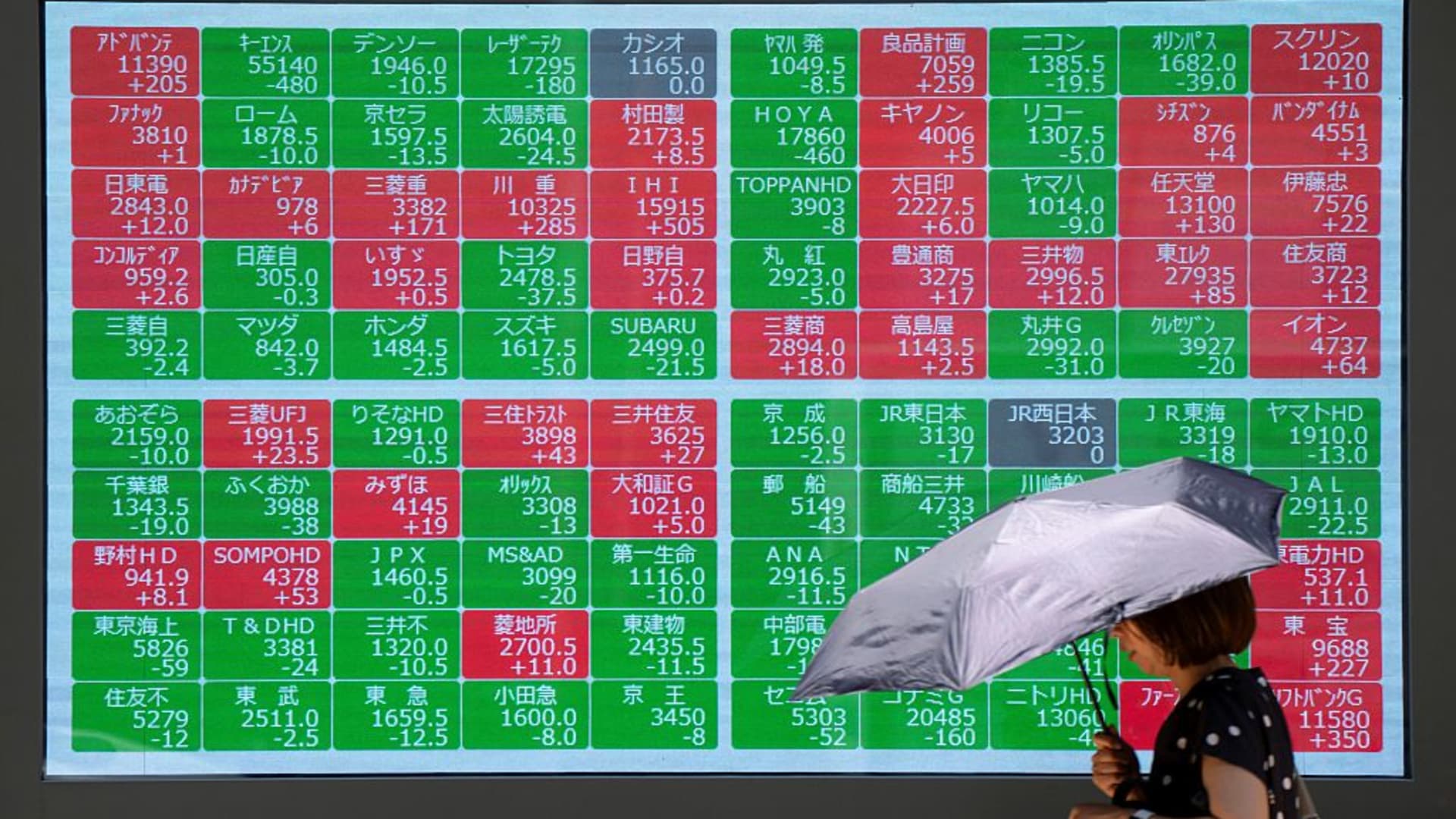
Nikkei 225, Kospi, CSI 300
Here are the opening calls for the day
Happy mid-week from Singapore. Asia markets are set for a mostly higher open.
Japan’s Nikkei 225 was set to open higher, with the futures contract in Chicago at 43,325, while its counterpart in Osaka last traded at 43,280, against the index’s last close of 42,718.17.
Futures for Hong Kong’s Hang Seng index stood at 25,144, pointing to a higher open compared with the HSI’s last close of 24,969.68.
However, Australia’s S&P/ASX 200 was set to start the day lower with futures tied to the benchmark at 8,852, compared with the index’s last close of 8,880.8.
— Lee Ying Shan
S&P 500 hits new intraday high
Traders work on the floor of the New York Stock Exchange on August 11, 2025.
NYSE
The S&P 500 rose 0.8% on Tuesday to hit a new intraday high.
S&P 5D chart
During the session, the S&P 500 surpassed its prior high from July 31. A closing high would be the S&P’s 16th of the year.
Earlier in the morning, the Nasdaq Composite also hit a new intraday high. A record close would be the benchmark’s 19th of the year.
— Nick Wells, Lisa Kailai Han
Continue Reading
-
Ming-Chi Kuo reveals TSMC’s new Supplier of Advanced Packaging Materials for Apple’s 2026 iPhone and Mac processors – patentlyapple.com
- Ming-Chi Kuo reveals TSMC’s new Supplier of Advanced Packaging Materials for Apple’s 2026 iPhone and Mac processors patentlyapple.com
- Forget the iPhone 17 — next year’s iPhone 18 due for huge performance boost Tom’s Guide
- A20 Chips in iPhone 18 Models Again Rumored to Feature New Design MacRumors
- Next year’s iPhones could get bigger than usual upgrades with A20 chip 9to5Mac
Continue Reading
-

Art Fein, Los Angeles rock-scene renaissance man, dead at 79
Art Fein, a Los Angeles music-scene renaissance man who worked as a journalist, publicist, manager and television host over a six-decade career, has died. He was 79.
Fein died of heart failure on July 30 while recovering from surgery for a broken hip, according to Cliff Burnstein, co-founder of Q Prime Management and a longtime friend.
Arthur David Fein was born June 17, 1946. Growing up in Chicago, he was transfixed by a Chuck Berry concert at age 10 and devoted his life to discovering, championing and preserving rock music. After moving to Los Angeles in 1971 to pursue a career in music journalism, he got a job in Capitol Records’ then-nascent college promotion department. There, he befriended John Lennon and Yoko Ono, while coordinating interviews with college radio stations for Ono’s latest album, “Approximately Infinite Universe.”
After leaving Capitol, he wrote music reviews for the Los Angeles Times, Herald-Examiner, Billboard and others before being hired as music editor at Variety. “By the time I got this job, I was sick of the new, aggravating profession of rock criticism,” he recalled in his 2022 memoir “Rock’s in My Head.” “It was about writers, not the music. I wasn’t interested in being terribly critical. I was an advocate. I wanted to help the music along; rock critics wanted to help their sense of superiority.”
He returned to the label world with stints at Elektra/Asylum and Casblanca but pivoted to management, incubating a proto-punk scene that would yield influential L.A. acts like the Cramps, the Blasters and the Heaters. A compilation he assembled, 1983’s “(Art Fein Presents) The Best of L.A. Rockabilly,” became a bible for bands inspired by X and Social Distortion, which drew from vintage rockabilly but amped it up for the punk age.
His public access cable TV show, “Lil Art’s Poker Party,” featured interviews and performances with his favorite musicians and ran in SoCal for 24 years. Rhino Records co-founder Richard Foos recalled that “for years we had a weekly poker game either at his house or mine. I was there the night [music critic] Lester Bangs was playing. We started the first hand, started talking music, and never played another hand.”
In 1990, Fein published “The L.A. Musical History Tour: A Guide to the Rock and Roll Landmarks of Los Angeles,” a compendium of locations guiding readers to grave sites of stars such as Roy Orbison and Ritchie Valens, and sites where Sam Cooke, Janis Joplin, Marvin Gaye, Tim Hardin, Dennis Wilson and Darby Crash died.
Fein also developed a complicated relationship with producer Phil Spector, to whom Lennon had introduced Fein as the man who “knows all about music.” Fein became part of Spector’s inner circle, even into his deeply troubled years when he was convicted of murdering House of Blues hostess Lana Clarkson. Fein maintained contact with Spector even after he was sentenced to life in prison.
The Blasters’ lead guitarist Dave Alvin wrote on Facebook that “Back in the early days of The Blasters, when few outside of Rollin’ Rock Records knew or cared who we were, Art cared deeply. In early 1980, I was a wannabe poet working as a fry cook in Long Beach … Art Fein played ‘Marie Marie’ to a Welsh rock ‘n’ roll singer named Shakin’ Stevens, who quickly recorded my song and made it into a huge international hit. … Thanks to Art Fein, I was soon able to quit my job as a cook and pursue music. I can never, ever thank you enough for all you did for me, Art.”
Singer-songwriter-guitarist Rosie Flores added that “back in ‘94 when I was touring with Butch Hancock in Europe, I took a bad fall, at the end of our month-long tour. I slipped in the rain on a cobblestone street in London and severely broke my wrist. Three months later I was invited to sing at the Elvis [annual birthday] bash at The House of Blues … It was normal protocol to donate all the money from the proceeds of the show and give it to an organization or a charity. This year, Art surprised me and handed me a stack of money to the tune of $1,500 for my medical bills. I didn’t expect that at all [and] it brought tears to my eyes.”
In the closing lines of his memoir, Fein wrote that “I can’t say anything terribly pithy or canny about the state of record sales, or streaming, or new delivery systems. Or how YouTube or TikTok are shaping contemporary music.”
“It turns out I didn’t want to be in the music business; I wanted to be in the music,” he wrote. “There I remain.”
Fein is survived by daughter Jessie and wife Jennifer.
Continue Reading
-
Cats’ Brains and Alzheimer’s Disease: PETA Statement on New Study – PETA
- Cats’ Brains and Alzheimer’s Disease: PETA Statement on New Study PETA
- Feline Dementia Mirrors Human Alzheimer’s Neuroscience News
- Cats with dementia show brain changes similar to Alzheimer’s in humans News-Medical
- Cats Show Alzheimer’s Changes; MS Lesions Start Early; Contested Paper Retracted MedPage Today
- Cats develop dementia similarly to humans – study MSN
Continue Reading
-
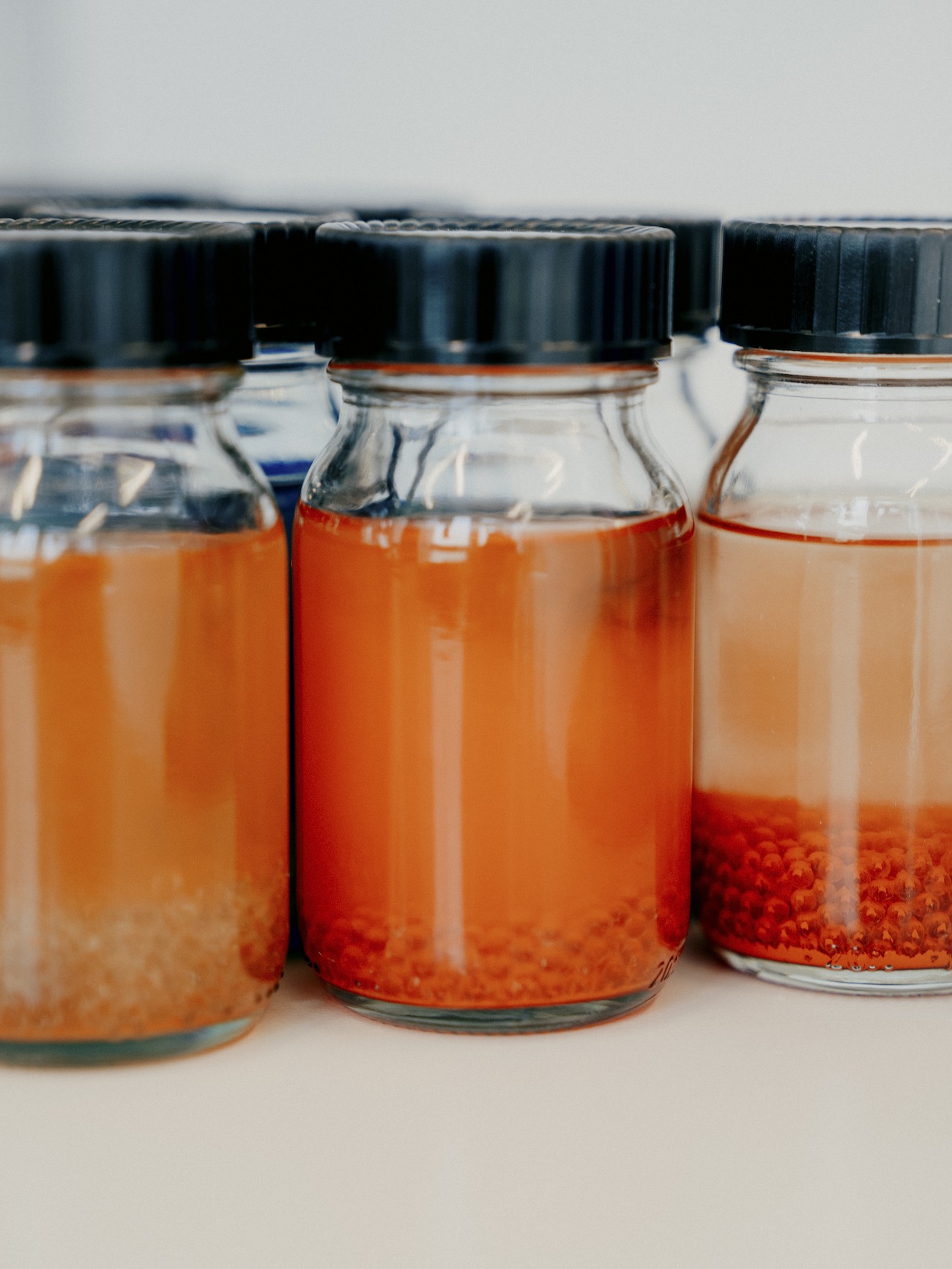
How Hempel created a paint empire powering ships, skyscrapers and Farrow & Ball
Farrow & Ball is known for its outré colour names that include “Elephant’s Breath”, “Arsenic” and “Dead Salmon” but the company that owns the UK paint-maker has more than the luxury interiors market covered. Hempel a/s, a 109-year-old Danish company that owns various brands such as Crown, also manufactures cutting-edge coatings including those that adorn London’s Tower Bridge, the Louvre Abu Dhabi and Amsterdam’s Schiphol Airport. Elsewhere, its innovations can be glimpsed on the exteriors of oil rigs and gas platforms, as well as wind-turbine blades and ship’s hulls. All are rigorously formulated to reduce drag and pollution, and dazzle for far more than their hue.
Orange, the new black? 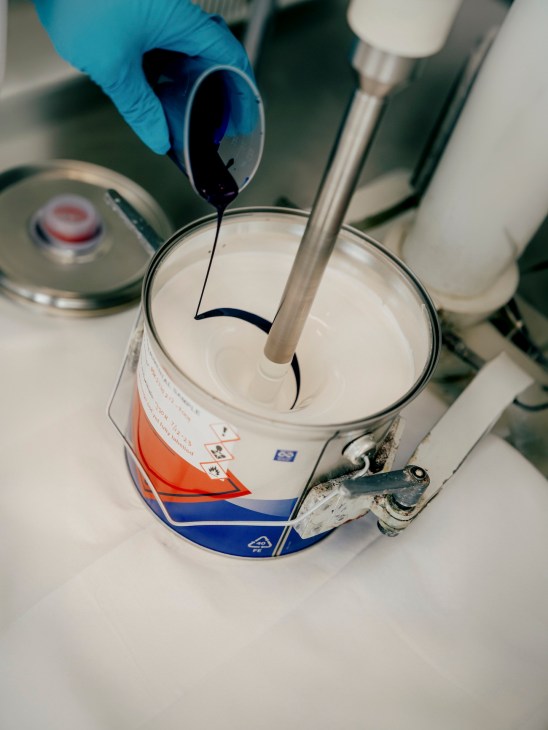
Marine paint Watching paint dry has never been this fascinating or this lucrative: in 2023, Hempel’s revenue grew by a record 13.7 per cent to €2.4bn. “Our marine business has seen huge growth in the past three years,” says Michael Hansen, Hempel group president and CEO, when Monocle meets him just north of Copenhagen at the company’s headquarters in Lundtofte. “Shipping is experiencing a paradigm shift. The focus now is on the environment and decarbonisation. Our marine coatings are here to help these organisations achieve their goals. If we can solve the biggest challenges facing the wind-energy industry, there is potential for real growth there too.”
The technicians in the research and development technology centre downstairs are busy tackling these issues. As Monocle dons anti-static overshoes, goggles and white coats, formulations specialist Camilla Holmberg informs photographer Mathias Eis that, due to the solvents used, this is an atex (“explosive atmosphere”) zone. For safety reasons, he’ll need to shoot at a minimum height of 80cms. First we visit the Colour Room, which is painted the most neutral of greys, where colours can be assessed under all sorts of lighting conditions. Next, Holmberg hands me a tongue of polyurethane paint that is used to coat the blades of wind turbines. Rain is an existential threat to offshore wind farms. In testing, Hempel subjects the blades to its helicopter-engined weather simulator and they come out looking like they’ve been gnawed by a colony of vicious rabbits. The paint’s rubbery texture counteracts this by enhancing wind resistance and providing protection against adverse conditions. Another of its miracle paints can help to maintain the integrity of burning buildings by puffing up to 50 times its original volume. It can withstand temperatures of 500c and is typically used for oil refineries but also coats the steel frame of Schiphol Airport.

CEO Michael Hansen 
Chief people and culture officer Pernille Fritz Vilhelmsen Hansen is particularly proud of Hempel’s newer marine coatings: one protects hull interiors against brutal cargos while also being easy to clean, enabling a quick turnaround in ports; another super-slippery, self-polishing, silicone-based external paint can reduce drag, and therefore fuel usage, by more than 17.7 per cent. There’s even a special paint to smooth over vertical welds on a ship’s outer hull. “This is really cool because welds are structural and you can’t grind them down,” says Hansen, taking nerdy delight in the details. “Using our paint on welds alone can reduce fuel consumption by 2 to 3 per cent. And it’s biocide-free, so it’s non-toxic.” To demonstrate the challenges faced when applying marine paints, Holmberg shakes a bottle of tomato ketchup. “To paint a ship, you need to be able to spray it but it mustn’t run or drip,” she says. “Just like ketchup when you shake it out of the bottle, it has to flow with the perfect consistency.”
In this context, Hansen’s move from shipping to paint, after 19 years at Danish shipping giant Maersk, doesn’t seem like such an odd career change. As he notes, Hempel started out in 1915 and Maersk was its first major customer. It was responsible for formulating the trademark “Maersk blue”. There are similarities between the company’s founders too. “Like Maersk, JC Hempel was a very entrepreneurial, outward-looking and innovative man: he went into the Middle East and Asia in the 1960s, for example,” says Hansen. “In addition to this, he firmly believed in moral responsibility.”

Protective clothing This mindset led Jørgen Christian Hempel, who died 1986 aged 91, to effectively give away his fortune in 1948 when he created the Hempel Foundation, which is still the sole owner of the company. “He did it primarily to protect the group from a hostile takeover but over the past 20 years it has grown as a philanthropic foundation, giving more and more to charity,” says Hansen. Many of Denmark’s larger organisations, such as Lego, Maersk and Carlsberg, have separate charitable foundations but it is rarer for an entire company to be owned and run by them. It does have implications when the company needs to raise funds, though. “True, it means that we have to live from our own retained earnings but we want to be the industry leader in sustainability. For that, it is an advantage to have the foundation’s long-term approach. Above all, the fact that our dividends go to philanthropy gives the people who work here a huge sense of purpose.”
“The foundation is a major reason why so many people are drawn to roles at Hempel,” says Pernille Fritz Vilhelmsen, chief people and culture officer. “When we go to work, we know that our proceeds are not going straight to shareholders or an owner but towards doing good. It is a unique proposition in terms of employer branding and we do use it in recruitment.”

Inside Hempel’s HQ This purpose-driven loyalty is one of the reasons why Hempel is considered to be among the best companies in Denmark to work for. Its HQ is appealing too. Built by Swedish architects Sweco, it has a central spiral staircase that emulates a can of paint being stirred. There is a fully staffed canteen and working hours are flexible. “Our Danish business is [financially] insignificant but we are still inspired by the country’s values,” says Hansen, who took over the top post a year-and- a-half ago. “We put our people first because innovation doesn’t come from nowhere. It also makes sense to be in Denmark. It’s easy to reach the rest of the world from Copenhagen; the reputation for quality of life here means that we attract overseas talent; and we have access to educated labour.” Since 2017 the Hempel Foundation has supported a science and technology centre within The Danish Technical University (DTU) that specialises in sustainable coating solutions. Once they have concluded their studies, many graduates join the organisation.
7,500
Employees in total (including 400 in the Danish HQ, 1,300 in the UK and 1,000 in China).400 million
Total amount of paint produced in litres in 2023.6,500
Number of Hempel paint standards.26
Number of factories, plus 15 R&D centres.€21m
The Hempel Foundation: has total assets of €848m and donated a record €21m in 2022.Hempel’s business is divided into four sectors. Besides its marine, infrastructure and energy ventures, it also runs a decorative operation. Under this umbrella is paint and wallpaper company Farrow & Ball, which was founded in 1946 in Dorset, England, where it is still based. In 2021 it was bought by Hempel from US private-equity firm Ares for a reported €580m. The decorative arm also includes Crown Paints and JW Ostendorf in Germany. Farrow & Ball showrooms and Crown Decorating shops make up some of the 200 or so high street shops that Hempel runs in the UK. “Sometimes I wonder why we aren’t solely available online but the painting and decorating industry is surprisingly conservative,” says Hansen. “It turns out that professionals love to come into the shops for a cup of coffee before they start their day. It’s a big part of the appeal.” The decorative sector boomed during the coronavirus pandemic but has been hit by energy and material price hikes over the past two years. “There are still real challenges,” says Hansen. “Decorative hasn’t recovered yet.”

Paint samples in the Colour Room 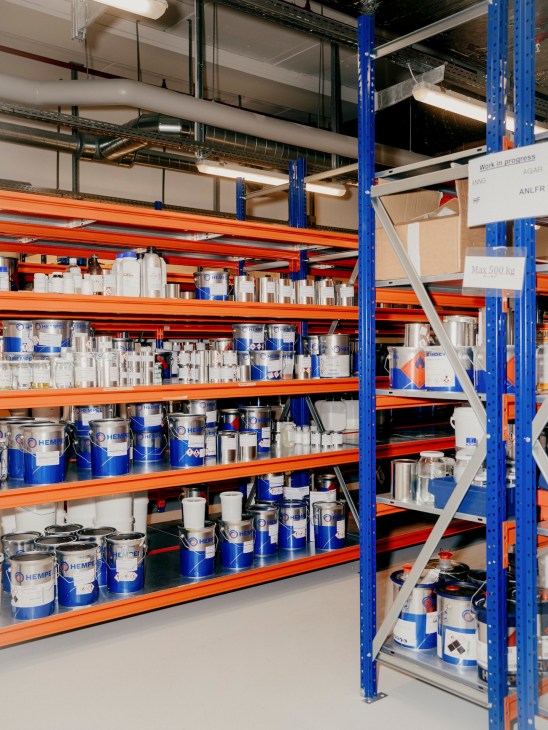
The R&D lab’s paint storage Ana Henriques, Hempel’s executive vice-president, head of decorative, is partly responsible for nurturing the sector back to health. Henriques joined the company from AB InBev in New York and has faith that the consumer brands can innovate their way back to greater revenues. “Farrow & Ball has always been a pioneer: we were the first to have showrooms rather than just traditional paint shops,” says Henriques.
“We have also embraced working with colour consultants, e-commerce and collaborating with designers. These days we are very well connected with influencers and a have a more-than-two-million-strong following on social media. But what comes first is the quality of our products, which are known for their richness and depth of colour.” In total, Farrow & Ball uses 12 different pigments to blend its 132 current shades. Historically, pigments would have come from a wide range of unusual sources: “India Yellow”, for instance, was once made from the urine of cows fed on a diet of mango leaves. Today they are all chemically created. The company is in the middle of gently revamping its colour range – something that happens every five years. The expectation this year is that surfaces that were painted at the height of the coronavirus pandemic will be looking a little tatty. “It has been a while since everyone redecorated,” says Henrique.
The air that we breathe in our homes and offices is a major topic among Danish architects right now. Volatile organic compounds (VOC), which are released when paint is applied, and over the longer term, are of particular concern. “Farrow & Ball was the first company to go 100 per cent water-based,” says Henriques. “People want their homes to feel healthy: they don’t want the smell of paint to linger, which means that they are going for low VOC options [Farrow & Ball paints are low- trace VOC – the best rating]. They also want to use colour to create specific moods.”
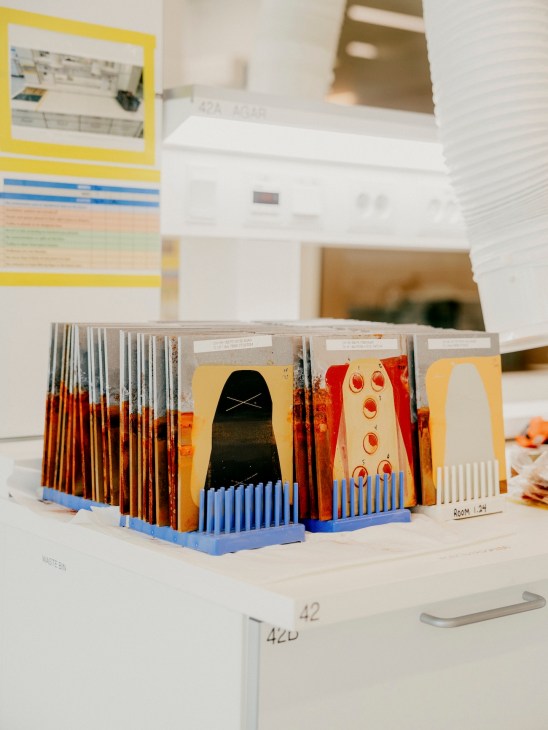
What’s on the cards? 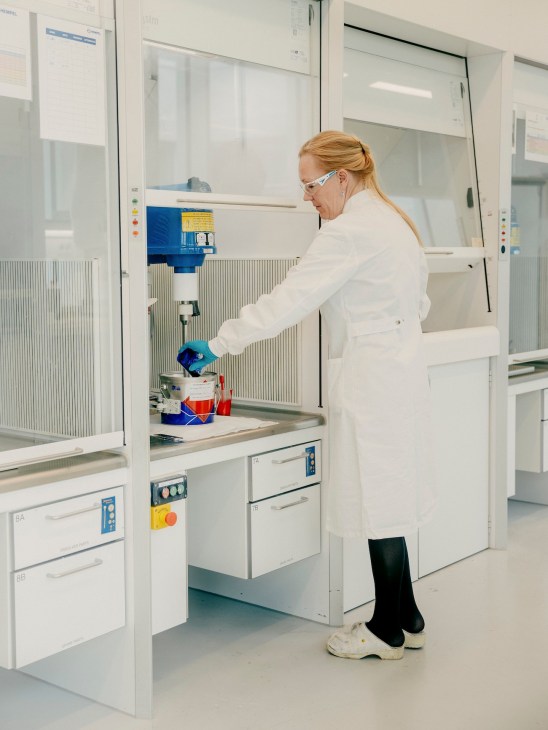
Camilla Holmberg, formulations specialist Customers can enlist the help of Farrow & Ball’s colour-consultancy service, which sees a representative visit homes to suggest a palette of calming tones or energising combinations. Before the end of the year the company will also offer an upgraded virtual service. It will then be possible to scan rooms, furniture included, on your phone and see the effect of different paints.
As a global company, Hempel employs a cross-cultural approach to colour and finish. “We have colour-trend teams who keep an eye on textiles, fashion, ceramics and social media,” says Henriques. “For instance, customers in the Middle East look for external paint in natural shades, you won’t see dark colours on houses and finishes need to withstand sand erosion. Cooler climates tend to like yellowish hues. In hotter climates, where the use of whiter indoor lighting is more widespread, colours appear differently. Big, bold reds are having a moment in Germany but in Scandinavia everything is white. Different countries are also drawn to different textures: in the US, smooth surfaces appeal whereas in Germany more ‘movement’ is allowed.” Even the way in which professionals work with Hempel varies. “In Germany, people prefer to use an oval paint bucket so that they can dip the roller straight in, unlike in other places, where they use trays.”
Looking ahead, the popularity of cold greys is waning and warmer tones might be returning to favour. But right now, Henriques detects a definite lust for coatings with depth. “Very rich green is having a bit of a moment,” she says, nodding emphatically.
Continue Reading
-

Colorado rabbits spotted with scary ‘horns and tentacles’ on their head; experts warn locals of growth virus
Residents in Fort Collins and other parts of Colorado have spotted wild rabbits with ‘scary’ horn-like and tentacle-shaped growths protruding from their heads and faces. Photos circulating on social media have startled locals. They show the animals with black, spiny structures resembling toothpicks or quills, sparking alarm and speculation about possible diseases.
Colorado residents have spotted several rabbits with tentacle-like growth(X) Wildlife experts revealed that the unsettling condition is caused by Shope papilloma virus, a disease that creates wart-like tumors on rabbits, often around the head, ears, and eyelids. While the growths may look disturbing, officials stressed they do not pose a threat to humans, pets, or other wildlife.
The virus only spreads between rabbits, typically through bites from insects such as mosquitoes and ticks. According to the University of Missouri, the condition is a DNA virus ‘seen most frequently in cottontail rabbits of the Midwest with outbreaks in domestic rabbits’.
Local Sightings and reactions
Fort Collins residents have reported multiple sightings, including one rabbit that returned to a homeowner’s yard for two consecutive years with increasingly severe growths.
Some residents initially feared the animals had plague or another dangerous illness.
Descriptions of the appearance range from ‘black quills’ to a ‘scabby growth’ covering parts of the face.
“I thought he would die off during the winter, but he didn’t,” a local, Susan Mansfield, told NBC local affiliate KUSA.“He came back a second year, and it grew.”
What is Shope Papilloma Virus?
The virus causes benign wart-like tumors, but in some cases, these can become malignant (cancerous). While generally not harmful to the rabbit’s overall health, tumors can create problems if they obstruct the mouth, nose, or eyes.
The disease is relatively common in wild rabbit populations, particularly during warmer months when insect activity is high.
There is no known cure for the virus; surgical removal of tumors is sometimes performed for domestic rabbits.
Colorado Parks and Wildlife is advising residents to keep their distance. The rabbits are not dangerous.
Continue Reading